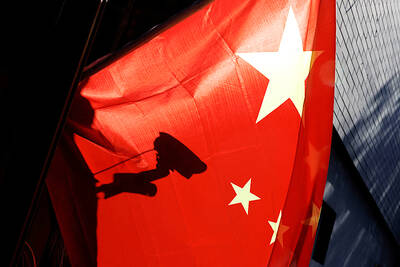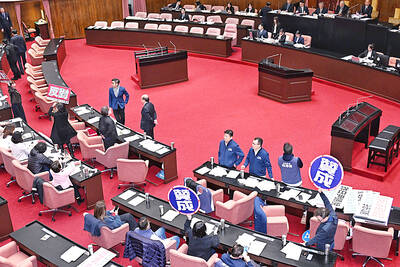Nationalists raised Japanese flags on an island at the heart of a corrosive territorial row with China yesterday, in a move likely to further inflame tensions with Beijing.
About a dozen members of the right-wing group Gambare Nippon (“Hang In There, Japan”) swam ashore, an Agence France-Presse (AFP) journalist witnessed, from a 20-boat flotilla carrying activists and lawmakers.
The landing comes just days after Tokyo deported pro-Beijing protesters who had landed on the island, part of a chain administered by Japan, but claimed by China, which had warned against acts “harming” its territorial sovereignty.

Photo: AFP
Tokyo politician Eiji Kosaka, one of the men who made it to the island, said the group had planted Japanese flags on a hillside and on the shore.
“This is undoubtedly Japanese territory,” he told an AFP reporter aboard the flotilla on his return. “On the mountain we found [the ruins of] Japanese-style houses that had places for drying fish.”
“It is very sad that the Japanese government is doing nothing with these islands,” he said, adding that the nationalists’ expedition had been “a great success.”
The 150 people who had made the voyage, including eight parliamentarians, sailed back to far southwestern Ishigaki yesterday. They had spent about five hours at the islands, known as the Senkaku Islands in Japan and the Diaoyutai Islands (釣魚台) in Taiwan.
Japanese Coast Guard ships had urged the activists not to land, with officers boarding some of the vessels to question people. No arrests were made.
China reacted with vehemence.
“Japanese right-wingers illegally violated China’s territorial sovereignty,” a statement quoted foreign ministry spokesman Qin Gang (秦剛) as saying. “The foreign ministry has already lodged solemn representations and expressed strong protest to the Japanese embassy in China and urged Japan to stop actions which harm China’s territorial sovereignty.”
Before the voyage, Kenichi Kojima, a local politician from Kanagawa, near Tokyo, said the trip was about who owned the archipelago, whose seabed is believed to harbor rich mineral resources.
“I want to show the international community that these islands are ours. It is Japan’s future at stake,” he said.
Organizers, who had been refused permission by Tokyo to go ashore, said ahead of their departure that they would be holding a ceremony aboard boats to remember some of those who died in World War II.
In Tokyo, Japanese Vice Foreign Minister Tsuyoshi Yamaguchi said established practice was for only government officials to land there.
However, he added: “In principle, it is alright for Japanese people to visit Japanese territory.”
The dispute over the islands is one of the major stumbling blocks — along with issues related to Japan’s military occupation of parts of China during World War II — to smooth relations between Asia’s two giant economies.
Tensions spiked as Japan deported 14 pro-China activists who sailed to the islands from Hong Kong.
Some managed to land on Uotsurijima, the largest island, becoming the first non-Japanese to set foot on any part of the archipelago since 2004.

A magnitude 7.0 earthquake struck off Yilan at 11:05pm yesterday, the Central Weather Administration (CWA) said. The epicenter was located at sea, about 32.3km east of Yilan County Hall, at a depth of 72.8km, CWA data showed There were no immediate reports of damage. The intensity of the quake, which gauges the actual effect of a seismic event, measured 4 in Yilan County area on Taiwan’s seven-tier intensity scale, the data showed. It measured 4 in other parts of eastern, northern and central Taiwan as well as Tainan, and 3 in Kaohsiung and Pingtung County, and 2 in Lienchiang and Penghu counties and 1

A car bomb killed a senior Russian general in southern Moscow yesterday morning, the latest high-profile army figure to be blown up in a blast that came just hours after Russian and Ukrainian delegates held separate talks in Miami on a plan to end the war. Kyiv has not commented on the incident, but Russian investigators said they were probing whether the blast was “linked” to “Ukrainian special forces.” The attack was similar to other assassinations of generals and pro-war figures that have either been claimed, or are widely believed to have been orchestrated, by Ukraine. Russian Lieutenant General Fanil Sarvarov, 56, head

FOREIGN INTERFERENCE: Beijing would likely intensify public opinion warfare in next year’s local elections to prevent Lai from getting re-elected, the ‘Yomiuri Shimbun’ said Internal documents from a Chinese artificial intelligence (AI) company indicated that China has been using the technology to intervene in foreign elections, including propaganda targeting Taiwan’s local elections next year and presidential elections in 2028, a Japanese newspaper reported yesterday. The Institute of National Security of Vanderbilt University obtained nearly 400 pages of documents from GoLaxy, a company with ties to the Chinese government, and found evidence that it had apparently deployed sophisticated, AI-driven propaganda campaigns in Hong Kong and Taiwan to shape public opinion, the Yomiuri Shimbun reported. GoLaxy provides insights, situation analysis and public opinion-shaping technology by conducting network surveillance

‘POLITICAL GAME’: DPP lawmakers said the motion would not meet the legislative threshold needed, and accused the KMT and the TPP of trivializing the Constitution The Legislative Yuan yesterday approved a motion to initiate impeachment proceedings against President William Lai (賴清德), saying he had undermined Taiwan’s constitutional order and democracy. The motion was approved 61-50 by lawmakers from the main opposition Chinese Nationalist Party (KMT) and the smaller Taiwan People’s Party (TPP), who together hold a legislative majority. Under the motion, a roll call vote for impeachment would be held on May 19 next year, after various hearings are held and Lai is given the chance to defend himself. The move came after Lai on Monday last week did not promulgate an amendment passed by the legislature that